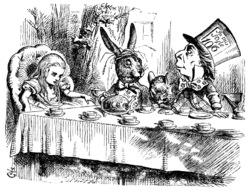
To be as "mad as a March hare" is an English idiomatic phrase derived from the observed antics said to occur [1] only in the March breeding season of the European hare (Lepus europaeus). The phrase is an allusion that can be used to refer to any other animal or human who behaves in the excitable and unpredictable manner of a March hare. [2]
